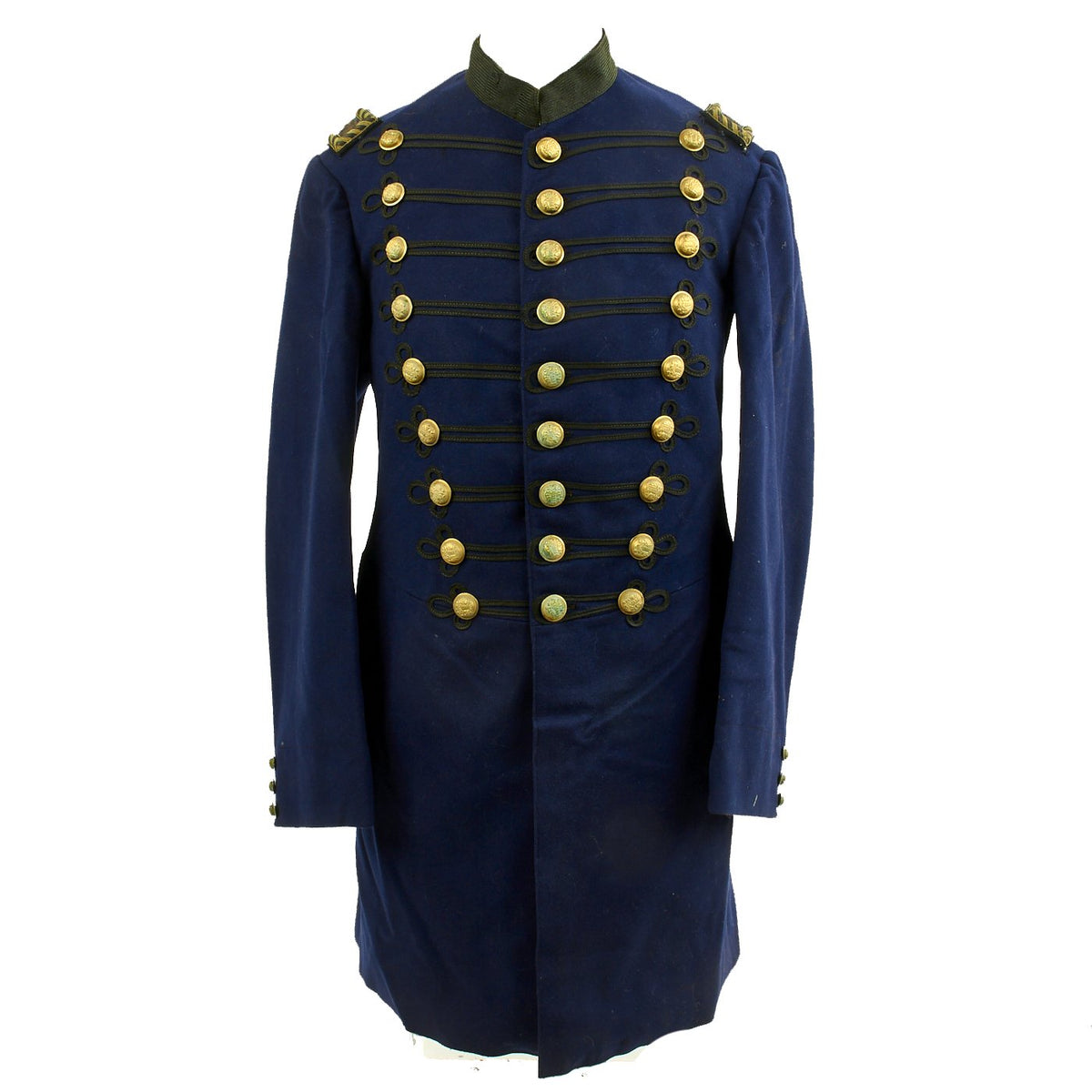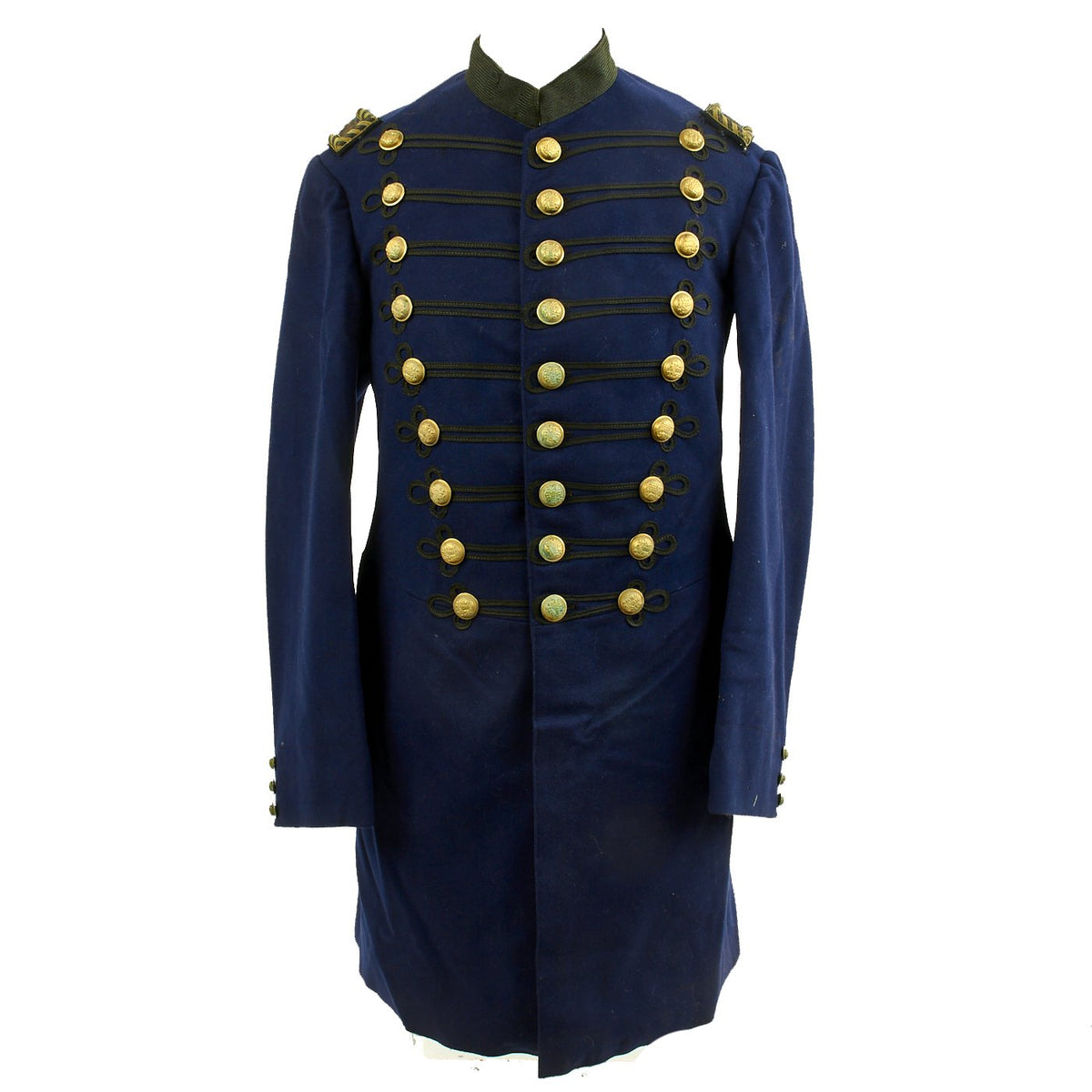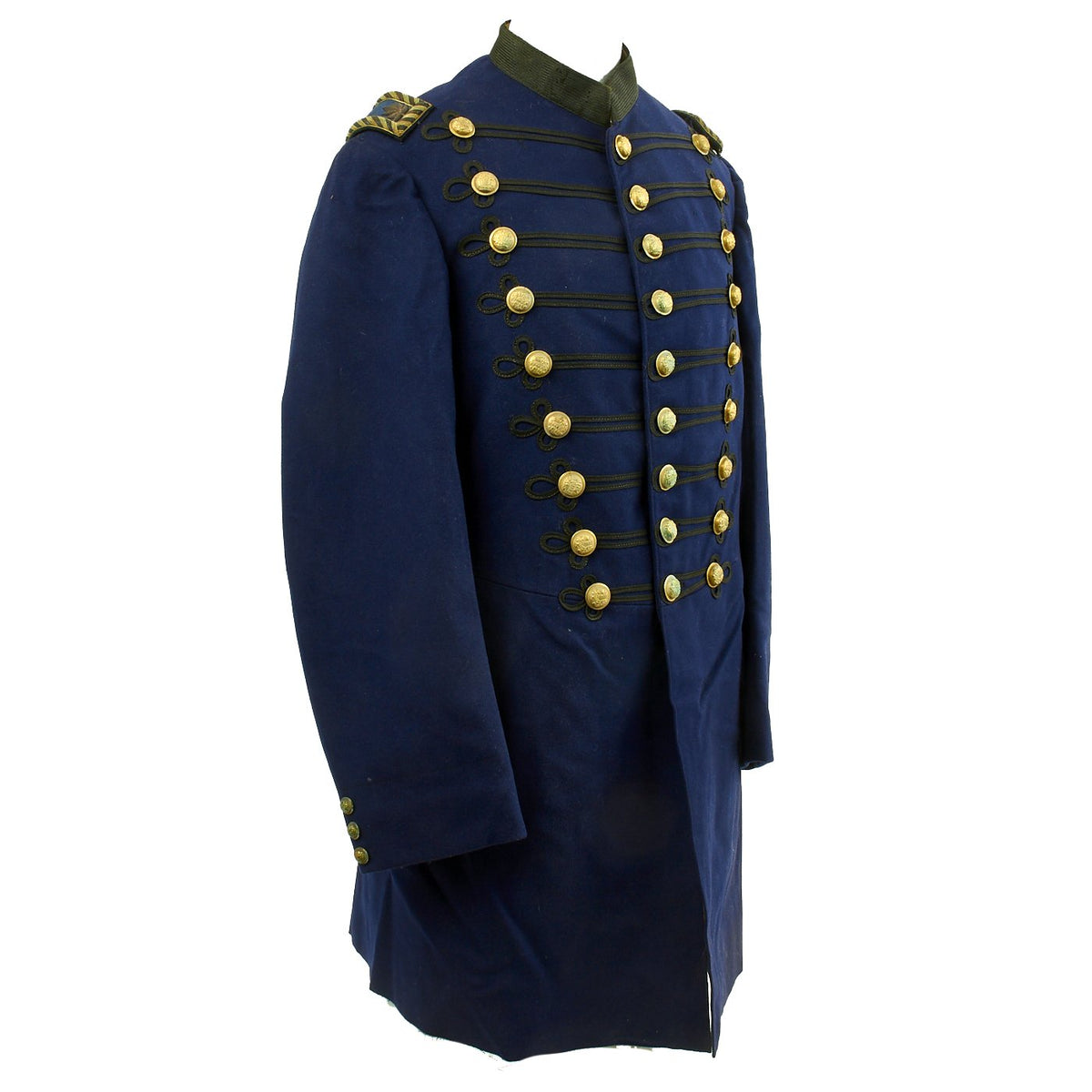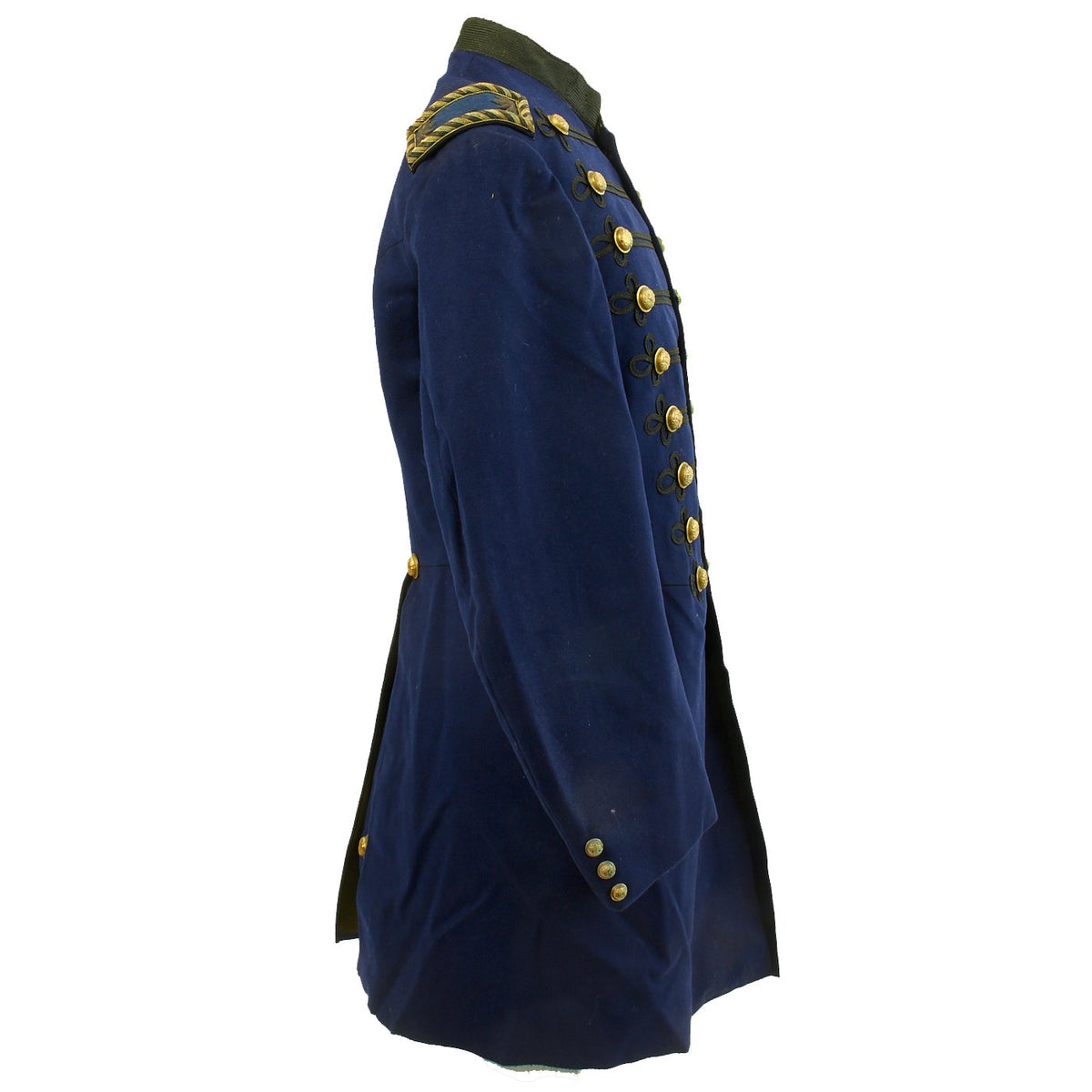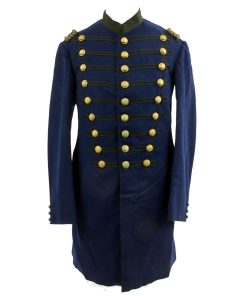Original 19th Century New Jersey National Guard Officer Frock Coat Original Items
$ 350,00 $ 105,00
Original Item: Only One Available. New Jersey National Guard Officer’s Dress Coat, doing from the late nineteenth century, blue wool with black collar and braid. Features three rows of nine New Jersey State Seal buttons with HORSTMANN, PHILLADELPHIA backmarks, four identical buttons on back (one missing), and three smaller buttons on each cuff. Shoulder Straps have blue felt bases and bullion embroidered Major insignias. Fantastic named WM H. HORSTMANN COMPANY label inside internal packet.
Approximate Measurements:
Collar to shoulder: 9”
Shoulder to sleeve: 24”
Shoulder to shoulder: 17”
Chest width: 18”
Waist width: 18”
Hip width: 25”
Front length: 37″
The New Jersey National Guard, 1869 to 1900
In April 1869, New Jersey Adjutant General William Scudder Stryker presided over the overhaul of the Militia and the New Jersey Rifle Corps and their consolidation into the New Jersey National Guard. The new Fourth regiment of the National Guard, for example, resulted from merging a number of companies of the Fourth Regiment, New Jersey Rifle Corps and the Second Regiment, Hudson Brigade, New Jersey militia.
The post-Civil War New Jersey National Guard was a significant improvement over the state’s “shreds and patches” 1860 militia. There were Civil War veterans at all levels of command, organized units on the regimental and brigade level, annual reviews and inspections and even a “Competitive Trial of Skill in Musketry,” held at various places around the state. In 1870 the competition was held in New Brunswick. It was literally a “Skill in Musketry” exercise, as the state’s military was still armed with Civil War era rifle-muskets, even though the regular army and some other state militia organizations had moved on to breech- loading metallic cartridge small arms. New Jersey, unlike other states, including neighboring New York, had elected to await official federal issue of breechloaders, rather than purchase its own.
Although there was no war on the horizon, and there would not be for many years, National Guard units were occasionally called out for local domestic duty, including answering the call of the Camden County sheriff to control a November 8, 1870 election riot at Centreville, where the Guard “restored the authority of the law” to the sheriff’s satisfaction.
Other less than glorious National Guard assignments included playing the opposition force for Civil War veteran battle reenactments. Although there had been some small local mock battles staged even while the war was going on, the first large demonstration, sponsored by former general Judson Kilpatrick, who was running for election to Congress, was held on Kilpatrick’s property in Sussex County’s Deckertown. Never one to miss a chance at self-promotion, Kilpatrick dubbed his show “The First Reunion.” It featured parades, theatrical performances, food, gambling and beer tents, celebrity appearances by Kilpatrick and Congressman/General Dan Sickles and, reportedly, “loose women.” The party was fueled by a trainload of beer shipped to Deckertown from New York City, and drew some 40,000 spectators, 4,000 veterans and a National Guard detachment. As theater, it was a magnificent event, but Kilpatrick did not get to Congress.
In September 1883, the New Jersey chapter of the Grand Army of the Republic veterans’ organization invited the Fourth and Sixth New Jersey National Guard regiments to attend its Fourth Annual Encampment at Princeton Junction. The encampment involved meetings, speeches, drills, — and drinking. The event was capped off by a battle reenactment with the veterans versus the National Guard. The “battle” between 250 veterans and a like number of Guardsmen, staged before over 4,000 spectators, took place on the last day of the encampment. To the horror of the local press, the mock combat resulted in a number of casualties, with thirteen men considered seriously wounded, three of whom needed additional care in the weeks afterward.
Although it was a better organized force than the old militia, the National Guard’s training schedule did not feature tactical field exercises, save the occasional mock combat with inebriated veterans. In 1875, for example, when the force was composed of “sixty-five companies of Infantry, two companies of Cavalry and two batteries of Artillery,” organized into several regiments and two brigades, the only combined training exercises were a parade and review in Newark for the First Brigade and a parade and review in Beverly for the Second Brigade. Adjutant General Stryker was concerned that the Guardsmen had no permanent practice range to shoot their newly issued Springfield breech loading .45-70 caliber rifles the state had finally received from the federal government. He reported that “it would be of great advantage…if some plan could be devised, whereby all the force could have some regular season and a suitable place to gain a more perfect use of the weapon.” It would be a decade before this problem was resolved.
Beginning in March, 1878, National Guardsmen had occasional access to the range of the New Jersey Rifle Association at Brinton, near Elizabeth, for marksmanship training, which evidently proved effective for at least some shooters, as a New Jersey team won a prize at the interstate rifle match at Creedmoor rifle range on Long Island in the fall of 1878.
Marksmanship, following national trends, continued to be stressed through the next two decades, and in 1879 the state arsenal created special reduced power cartridges for the .45-70 caliber rifles so they could be used for practice on limited distance indoor ranges in armories around the state. National Guardsmen continued to shoot full power cartridges at the Brinton range of the New Jersey State Rifle Association near Elizabeth and also at the Stockton range outside Camden and at Creedmoor.
Routine bureaucratic tasks increased for the adjutant general’s office as the years passed. Stryker noted that he was receiving requests for “searches of records” for veterans who had apparently lost their initial discharges and other proof of service and were beginning to apply for pensions. Stryker was also completing his two- volume record of the Civil War service of New Jerseyans, in state units as well as the United States Colored Troops, for publication. The indexed result, published in 1876, is probably the best such printed record of a state’s servicemen of the era.
In the post-Civil War era, New Jersey black men, some no doubt veterans, became actively involved as soldiers in the peacetime military for the first time in the state’s history. The Adjutant General’s report for 1872 notes that the legislature authorized “companies of colored infantry” to serve in the National Guard. The number of African-American companies was legislatively restricted to no more than ten, and the companies were consolidated into the Eighth Regiment, National Guard of New Jersey. The Eighth was an all-black unit, which, like the wartime USCT, was commanded by white officers. During its existence the Eighth mustered a maximum of nine companies. A regimental headquarters and “field and staff” detachment was located in Camden, along with Companies C, D, E and I. Company A was stationed in Elizabeth, Company B in Trenton, Company F in New Brunswick, Company G in Jersey City and Company H in Newark. The Eighth regiment was not attached to either of the two National Guard Brigades composed of white soldiers, and declining enrollments led to the unit’s disbandment in 1877.
Stryker continued his work to record the service of Jerseymen in all the country’s conflicts to date as well as paying out pensions to surviving War of 1812 veterans and making preparations for the forthcoming United States Centennial Commemoration, in which selected units would participate in parades in Philadelphia in 1876, as well as other commemorations. In 1881 a hand-picked New Jersey detachment attended the 100th anniversary ceremonies of the battle of Yorktown, Virginia, and won a trophy for “presenting the best military appearance during the entire encampment.” At the end of 1876, the New Jersey National Guard mustered a strength of 3,862 officers and men. Throughout the post-Civil War era, yearly strength totals were similar, but varied somewhat as companies that did not meet the strength requirements were occasionally disbanded or consolidated with other units.10
In July of 1877, as the nation remained mired in the depression produced by the Panic of 1873, layoffs and wage cuts affected more and more workers, and a railroad strike that began in West Virginia spread across the country. National Guard troops in West Virginia refused to fire on the strikers, while Maryland Guardsmen engaged in pitched battles with them in Baltimore. Pennsylvania’s state military killed more than forty demonstrators in Pittsburgh, and federal troops were sent in to restore order. The conflict spread to the border of New Jersey, and Governor Joseph D. Bedle called up the National Guard in anticipation of violence, but none materialized, and he and other state political leaders did not view the Guard as being a strike breaking organization. Although there were a few minor disturbances, most New Jersey railroad workmen were apparently content with having their grievances heard by management and the public. The fact that the legislature had passed laws criminalizing railroad strikes may also have had an effect.
Annual inspections of National Guard units were conducted throughout the post- Civil War era, with mixed results. Some companies, and even regiments, were found to be lacking basic records and failed to meet expectations in other areas. Artillery Battery A, located in Hoboken, was the sole remaining artillery unit in the New Jersey Guard after Battery B was replaced by Camden’s Gatling Gun Company A in 1878. In an 1880 inspection the battery displayed, according to inspecting officer Lieutenant Colonel G. E. P. Howard, “a lack of proper discipline among both officers and enlisted men.” The unit was subsequently disbanded and a new Gatling gun battery was created in Elizabeth. While inspecting officers praised the record keeping and bearing of many units, one infantry company inspected in 1880 “seemed to know but little about the manual of arms or company movements.” Many units were still equipped with obsolete Civil War era cartridge boxes, with tin inserts designed for use with packets of shorter rifle-musket paper cartridges, and the inspector declared they were “unfit for the present fixed ammunition in general use.” To correct this problem, New Jersey acquired McKeever cartridge boxes from the federal government. The state had brass “NJ” plates made and shipped them to a federal arsenal to be affixed to the new boxes, which were specifically made for the .45-70 cartridge.
The new Gatling gun battery in Elizabeth, commanded by Civil War Medal of Honor recipient J. Madison Drake, quickly became a headache to state officials. Drake, a genuine war hero who mustered out of the Ninth New Jersey Infantry as a first lieutenant in 1865, was also active in the postwar New Jersey National Guard. He was elected colonel of the Third Regiment, and served for five years before resigning after convincing the state legislature to make him a brevet (honorary) brigadier general. When Drake, an influential newspaper man and author in civilian life, returned to the Guard as a captain commanding the Elizabeth company, he wore his brevet rank star and preferred being addressed as “general.” The company, which Captain/General Drake ran without regard for state or federal regulations, served as a home for his nationally known “Veteran Zouaves” drill team and marching society, much to the dismay of senior National Guard officials. The unit was finally ejected from the National Guard in 1892 for consisting of overage and overweight soldiers and failure to wear regulation uniforms – Drake would only allow Civil War veterans to join the company and they wore the Zouave uniform in service, while every other unit in the New Jersey National Guard wore the standard uniform. A new Gatling gun company was created in East Orange to replace Drake’s Zouaves.13
After leaving the National Guard, the Veteran Zouaves continued to tour the country for years afterward. They also appeared at a GAR veterans’ organization conventions and encampments, including one at Sea Girt in 1908. James Madison Drake, one of nineteenth century New Jersey’s most colorful characters, died at his home in Elizabeth on November 28, 1913, and was buried in Evergreen Cemetery in Hillside.
With the artillery batteries gone, in 1885 the legislature provided funding for the formation of a “gun detachment” in each regiment and separate battalion of infantry. Each detachment consisted of one first lieutenant (assigned to the regimental staff), one sergeant, one corporal and twelve privates. Selected enlisted men were detached from infantry companies and assigned to the Gun Detachment by regimental order. Each detachment was armed with one small 3.2-inch “hand drawn” naval boat howitzer and the men were issued .45 caliber Colt revolvers and sabers.15
By the time the new artillery pieces were issued, General Stryker’s long term wish for a permanent state-owned training site with a rifle range had been fulfilled. In his annual report for 1882, Stryker reinforced his earlier requests by commenting that “No better plan can now be devised than for the State to select some permanent summer camping ground for her troops,” and urged legislative action on the subject.
The search to meet Stryker’s requirements led to coastal southern Monmouth County, centrally located and readily accessible by rail from north and south, yet still relatively undeveloped. The New Jersey National Guard first came “down the shore” in August, 1884, to hold a five-day summer encampment at Manasquan at a leased site named “Camp Abbett” in honor of then Governor Leon Abbett, a practice that set a precedent for naming future camps after sitting governors. The encampment was commanded by Irish-born Brevet Major General William J. Sewell, a Civil War hero, Pennsylvania Railroad executive, Republican Party boss of Camden and United States senator. Sewell strongly supported buying land for a permanent camp in the area, which, he believed, would “keep our National Guard up to that state of efficiency that we can point to it with pride.”
The adjutant general chose a section of Sea Girt, a Monmouth County shore town slightly north of the 1884 campsite, to lease for National Guard use in the summer of 1885. The New Jersey Assembly subsequently authorized R. S. Jenkins of Camden and W. T. Hoffman of Jersey City to act as state agents to purchase 120 acres in Sea Girt, which the legislators proposed to condemn for government use at a compensation rate of $425 an acre. The ground, formerly owned by Commodore Robert Stockton and part of a parcel developers had acquired at an 1868 sheriff’s sale, was intended to serve a dual purpose – as a summer training camp for the National Guard and as an encampment site for the New Jersey posts of the Grand Army of the Republic, the Civil War Union Veterans’ Organization. Governor Abbett was convinced that “the amount saved by the State in using the camp for a rifle range will in ten years be sufficient to pay for the land, improve the same and erect necessary buildings.” Despite the governor’s enthusiasm, the purchase bill faced rougher sledding in the state senate, where a number of Senators opposed the condemnation proceedings, postponing state acquisition of the property.
Leon Abbett, who had personally approved the Sea Girt site, was one of New Jersey’s first “hands on” chief executives, and perhaps the greatest of its nineteenth century governors. A Jersey City Democrat who helped integrate immigrants into the political system, Abbett advocated fair taxation of railroads and promoted early civil rights legislation. After consultation on acquisition of the Sea Girt property with the “principal officers of the National Guard interested in the subject,” General Stryker agreed, that “it would be difficult…to find another site as suitable, combining the natural advantages for a Brigade or even Division camp, with ample parade ground, singularly adequate facilities for rifle range purposes and the advantages of safe surf bathing under proper restrictions.”
New Jersey continued to lease the land for the Sea Girt encampment from the Sea Girt Land Improvement Company for an annual rental fee of $3,000 until purchase legislation could be passed. Although locals complained of Guardsmen prone to “merrymaking,” at nearby resorts when off duty, the state would have its way, as Abbett’s successor Governor Robert S. Green pushed ahead on the sale, which was concluded during Green’s administration for a sum of $51,000, by appointed commissioners James Smith Jr., of Newark and William L. Dayton of Trenton. Following the initial acquisition, the state subsequently added a small parcel in 1907, but there is no formal record of the original sale extant today.
The Sea Girt site proved adaptable to practice with Gatling guns and the small artillery pieces issued to regimental gun detachments, which fired at targets anchored on rafts 400 to 800 yards offshore. In 1889, travel writer Gustav Kobbe noted that “the State camp, where the N.G.S.N.J. holds its annual field exercises during one week in August, is a beautiful tract of land whose entrance is near the [railroad] station. The glamour and bustle of military life and the ball given at the Beach House [a hotel in town] to the Governor and his staff make the encampment a welcome episode of the summer season.”
Over succeeding decades, the rifle range at Sea Girt attained a national and international reputation in an era when target shooting was a popular sport for both soldiers and civilians. Inspector General of Rifle Practice General Bird W. Spencer contributed lengthy detailed accounts of the state’s marksmanship training to the annual adjutant general reports and was also an officer in both the State and National Rifle associations as well as a long time mayor of Passaic. It was said that Sea Girt and its range were Spencer’s “passion.” When Spencer died in 1931, a special remembrance ceremony was held in his honor on the Sea Girt rifle range.
In the last years of the nineteenth century and the first decade of the twentieth, the New Jersey National Guard began to transition from a military-themed social and political club occasionally called out by the governor in civil disturbances into a more professional force. This trend, part of a national one, was fueled by National Guard officers who wanted to gain respect from their regular army counterparts as well as federal officials seeking a reliable organized backup force for the Regular Army in an era of growing national responsibilities. The first tentative steps in this direction began in the 1890s, with the assignment of regular army officers to advise and train state forces. In 1895, the first of these officers, Lieutenant Melvin W. Rowell of the Tenth United States Cavalry, was assigned to the New Jersey National Guard.
The presence of cavalry in the New Jersey National Guard had been erratic at best, at least partially due to the expense to the state of maintaining horses. In the last decade of the nineteenth century this situation would change, however. The Essex Troop had its origins in a civilian riding organization created in 1890 to act as a private honor guard for local dignitaries in Essex County. Colonel James E. Fleming, a former Civil War officer who had served in the Eleventh Pennsylvania Cavalry and was a member of the socially exclusive Essex Club, which gave the unit its name, was the troop’s commander. The members either owned their own steeds or rented them, bought their own saddles and were loaned revolvers and sabers by the state. On May 17, 1893 the Essex Troop joined the New Jersey National guard as Cavalry Company A.
The troop was decidedly an elite organization, and when it attended its first training session at Sea Girt, a newspaper that described it as “the crack mounted organization from Orange and Newark known as the Essex Troop” also noted that “the regular train on the Long Branch road had three special coaches attached to it, one containing the men and officers and the other the horses and servants.” The National Guard of the 1890s allowed units to design and privately purchase full dress garb beyond the regulations, and the Essex Troopers purchased uniforms based on a British “Hussar” style and custom tailored by Brooks Brothers in New York City. With the addition of the Essex Troop, the cavalry was back in the New Jersey National Guard to stay. A second troop, headquartered at Red Bank, joined the Guard in 1895.
Although the Essex Troop could be viewed as a unit of locally prominent dandies, the New Jersey National Guard as a whole was a relatively socially and economically diverse organization. In 1896 four out of ten of the state’s part-time soldiers were factory workers and mechanics and another three were clerks or bookkeepers.
The New Jersey Naval Militia was founded in 1894 and, organized into two detachments, the Battalion of the East and the Battalion of the West, began active operations the following year. The organization, activated in many but not all states, was intended to act as a naval reserve to be integrated into regular navy ship crews in time of war. An attempt to cut state spending by disbanding the Naval Militia failed in the New Jersey legislature in 1897, and a contemporary newspaper account of that year flatteringly described the unit as “composed principally of young business and professional men.” The active duty navy provided advising officers and training ships to the militia.
Along with supporting the National Guard, the state Quartermaster Department also loaned weapons and equipment to private paramilitary organizations like the Essex Troop before it joined the Guard, the Atlantic City Morris Guards and the Sons of Union Veterans, as well as Grand Army of the Republic veterans’ posts throughout the state. These allocations were reflected on the department’s annual report.
Fast Shipping with Professional Packaging
Thanks to our longstanding association with UPS FedEx DHL, and other major international carriers, we are able to provide a range of shipping options. Our warehouse staff is expertly trained and will wrap your products according to our exact and precise specifications. Prior to shipping, your goods will be thoroughly examined and securely secured. We ship to thousands clients each day across multiple countries. This shows how we're dedicated to be the largest retailer on the internet. Warehouses and distribution centres can be located throughout Europe as well as the USA.
Note: Orders with more than one item will be assigned a processing date depending on the item.
Before shipping before shipping, we'll conduct a thorough inspection of the items you have ordered. Today, the majority of orders will be delivered within 48 hours. The delivery time will be between 3-7 days.
Returns
The stock is dynamic and we cannot completely manage it because multiple stakeholders are involved, including our factory and warehouse. So the actual stock may alter at any time. It's possible that you may not receive your order once the order has been made.
Our policy is valid for a period of 30 days. If you don't receive the product within 30 days, we are not able to issue a refund or an exchange.
You can only return an item if it is unused and in the same state as the day you received it. You must have the item in its original packaging.
Related products
Uncategorized
Uncategorized
Armored Burgonet Helmet & Polearm from Scottish Castle Leith Hall Circa 1700 Original Items
Uncategorized
Uncategorized
Uncategorized
Uncategorized
Uncategorized
Uncategorized
Australian WWII Owen MK1 Machine Carbine SMG Custom Fabricated Replica with Sling Original Items
Uncategorized
Uncategorized
Uncategorized
Uncategorized
Uncategorized
Band of Brothers ORIGINAL GERMAN WWII Le. F.H. 18 10.5cm ARTILLERY PIECE Original Items
Uncategorized
Uncategorized
Uncategorized
Uncategorized
Uncategorized
Uncategorized
Uncategorized
